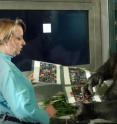If bonobo Kanzi can point as humans do, what other similarities can rearing reveal?
You may have more in common with Kanzi, Panbanisha and Nyota, three language-competent bonobos living at Great Ape Trust, than you thought. And those similarities, right at your fingertip, might one day tell scientists more about the effect of culture on neurological disorders that limit human expression. Among humans, pointing is a universal language, an alternative to spoken words to convey a message. Before they speak, infants point, a gesture scientists agree is closely associated with word learning. But when an ape points, scientists break rank on the question of whether pointing is a uniquely human behavior. Some of the world's leading voices in modern primatology have argued that although apes may gesture in a way that resembles human pointing, the genetic and cognitive differences between apes and humans are so great that the apes' signals have no specific intent.
Not so, say Great Ape Trust scientists, who argued in a recently published scientific paper, "Why Apes Point: Pointing Gestures in Spontaneous Conversation of Language-Competent Pan/Homo Bonobos," that not only do Kanzi, Panbanisha and Nyota point with their index fingers in conversation as a human being might, these bonobos do so with specific intent and objectives in mind.
The difference between pointing by the Great Ape Trust bonobos – the only ones in the world with receptive competence for spoken English – and other captive apes that make hand gestures is explained by the culture in which they were reared, according to the paper's authors: Janni Pedersen, an Iowa State University Ph.D. candidate conducting research for her dissertation at Great Ape Trust; Pär Segerdahl, a scientist from Sweden who has published several philosophical inquires into language; and William M. Fields, an ethnographer investigating language, culture and tools in non-human primates. Fields also is Great Ape Trust's director of scientific research.
Because Kanzi, Panbanisha and Nyota were raised in a culture where pointing has a purpose – The Trust's hallmark Pan/Homo environment, where infant bonobos are reared with both bonobo (Pan paniscus) and human (Homo sapiens) influences – their pointing is as scientifically meaningful as their understanding of spoken English, Fields said.
The pointing study supports and builds on previous research on the effect of rearing culture on cognitive capabilities, including the 40-year research corpus of Dr. Duane Rumbaugh, Dr. Sue Savage-Rumbaugh and Fields, which is the foundation of the scientific inquiry at Great Ape Trust. Those studies included the breakthrough finding that Kanzi and other bonobos with receptive competence for spoken English acquired language as human children do – by being exposed to it since infancy. The bonobos adopted finger-pointing behavior for the same reasons, because they were reared in a culture where pointing has meaning.
"We have argued that apes and humans, while very closely related genetically, differ most dramatically in culture," Fields said. "Pointing is a function of culture. If Kanzi can do the kinds of things that he is able to do as a function of rearing, what does that mean for humans?"
Fields said studying the effect of culture on great apes' cognitive capabilities might help scientists learn more about human disorders that cause developmental delays. "This opens the entire question of how you push the limits of genes by cultural forces, for instance in Down's Syndrome or other genetic variations that limit normal human expression," he said. "What is the role of culture as a mitigating strategy for Autistic Spectrum Disorders? Is IQ a function of culture?"
Answering those questions brings scientists a step closer to determining the role of epigenesis – the influence of the environment on the expression of the genetic code – in a variety of disciplines, including medicine, education and technology.
The Great Ape Trust scientists conducted the study in rebuttal to a paper written by Michael Tomasello, a leading expert on evolution and communication. Tomasello, co-director of the Max Planck Institute for Evolutionary Anthropology in Germany, asserted in "Why Apes Don't Point" that though captive apes may appear to point, the genetic and cognitive differences between apes and humans are so great that there is no specific intent behind the gesture.
Pedersen et al. argued that an ape that was not reared in a culture where index finger pointing was common, including most captive apes, would not be expected to exhibit that gesture. The scientists also noted that although pointing isn't a behavior that wild bonobos and other great apes acquire on their own, it does not mean that they are genetically or cognitively incapable of learning the behavior.
"Tomasello's argument rests upon questionable empirical evidence," Pedersen and her colleagues wrote, "since the apes in the referred experimental studies have not been relevantly reared. By providing evidence that language-encultured apes do point, the assumptions about the cognitive differences between humans and apes need to be called into question on both theoretical and empirical ground."
Source: Great Ape Trust of Iowa
Other sources
- If bonobo Kanzi can point as humans do, what other similarities can rearing reveal?from Science DailyMon, 1 Mar 2010, 19:14:47 UTC
- If bonobo Kanzi can point as humans do, what other similarities can rearing reveal?from PhysorgMon, 1 Mar 2010, 18:35:47 UTC
- If bonobo Kanzi can point as humans do, what other similarities can rearing reveal?from Science BlogMon, 1 Mar 2010, 18:07:41 UTC
